ETSI TS 101 545-1 V1.2.1 (2014-04)
Technical Specification
Digital Video Broadcasting (DVB);
Second Generation DVB Interactive Satellite System
(DVB-RCS2);
Part 1: Overview and System Level specification
�
2
ETSI TS 101 545-1 V1.2.1 (2014-04)
Reference
RTS/JTC-DVB-324-1
Keywords
DVB, interaction, satellite
ETSI
650 Route des Lucioles
F-06921 Sophia Antipolis Cedex - FRANCE
Tel.: +33 4 92 94 42 00 Fax: +33 4 93 65 47 16
Siret N° 348 623 562 00017 - NAF 742 C
Association à but non lucratif enregistrée à la
Sous-Préfecture de Grasse (06) N° 7803/88
Important notice
The present document can be downloaded from:
http://www.etsi.org
The present document may be made available in electronic versions and/or in print. The content of any electronic and/or
print versions of the present document shall not be modified without the prior written authorization of ETSI. In case of any
existing or perceived difference in contents between such versions and/or in print, the only prevailing document is the
print of the Portable Document Format (PDF) version kept on a specific network drive within ETSI Secretariat.
Users of the present document should be aware that the document may be subject to revision or change of status.
Information on the current status of this and other ETSI documents is available at
http://portal.etsi.org/tb/status/status.asp
If you find errors in the present document, please send your comment to one of the following services:
http://portal.etsi.org/chaircor/ETSI_support.asp
Copyright Notification
No part may be reproduced or utilized in any form or by any means, electronic or mechanical, including photocopying
and microfilm except as authorized by written permission of ETSI.
The content of the PDF version shall not be modified without the written authorization of ETSI.
The copyright and the foregoing restriction extend to reproduction in all media.
© European Telecommunications Standards Institute 2014.
© European Broadcasting Union 2014.
All rights reserved.
DECTTM, PLUGTESTSTM, UMTSTM and the ETSI logo are Trade Marks of ETSI registered for the benefit of its Members.
3GPPTM and LTE™ are Trade Marks of ETSI registered for the benefit of its Members and
GSM® and the GSM logo are Trade Marks registered and owned by the GSM Association.
of the 3GPP Organizational Partners.
ETSI
�
3
ETSI TS 101 545-1 V1.2.1 (2014-04)
Contents
Intellectual Property Rights ................................................................................................................................ 4
Foreword ............................................................................................................................................................. 4
Introduction ........................................................................................................................................................ 5
1
2
2.1
2.2
3
3.1
3.2
3.3
Scope ........................................................................................................................................................ 6
References ................................................................................................................................................ 6
Normative references ......................................................................................................................................... 6
Informative references ........................................................................................................................................ 6
Definitions, symbols and abbreviations ................................................................................................... 7
Definitions .......................................................................................................................................................... 7
Symbols .............................................................................................................................................................. 7
Abbreviations ..................................................................................................................................................... 7
4
4.1
4.2
4.3
4.4
4.5
4.6
4.7
4.8
4.9
4.10
4.11
4.12
4.12.1
4.12.2
4.12.3
4.12.4
4.13
4.13.1
4.13.2
4.14
System definition ...................................................................................................................................... 9
General ............................................................................................................................................................... 9
System Roles .................................................................................................................................................... 12
Physical layer ................................................................................................................................................... 12
Access layer ...................................................................................................................................................... 13
System architecture .......................................................................................................................................... 13
Network layer ................................................................................................................................................... 13
Management functions ..................................................................................................................................... 13
Traffic interception ........................................................................................................................................... 13
Terminal installation functions ......................................................................................................................... 13
Terminal future configurations [informational] ................................................................................................ 13
Terminal capabilities and profiles .................................................................................................................... 14
System versioning ............................................................................................................................................ 16
Forward Link .............................................................................................................................................. 17
Return link .................................................................................................................................................. 18
Management and Control Planes ................................................................................................................ 18
RCST Synchronisation and Logon ............................................................................................................. 18
Security aspects ................................................................................................................................................ 19
Transmission Security (TRANSEC) ........................................................................................................... 20
fLawful Interception ................................................................................................................................... 20
Evaluation and certification .............................................................................................................................. 21
History .............................................................................................................................................................. 22
ETSI
�
4
ETSI TS 101 545-1 V1.2.1 (2014-04)
Intellectual Property Rights
IPRs essential or potentially essential to the present document may have been declared to ETSI. The information
pertaining to these essential IPRs, if any, is publicly available for ETSI members and non-members, and can be found
in ETSI SR 000 314: "Intellectual Property Rights (IPRs); Essential, or potentially Essential, IPRs notified to ETSI in
respect of ETSI standards", which is available from the ETSI Secretariat. Latest updates are available on the ETSI Web
server (http://ipr.etsi.org).
Pursuant to the ETSI IPR Policy, no investigation, including IPR searches, has been carried out by ETSI. No guarantee
can be given as to the existence of other IPRs not referenced in ETSI SR 000 314 (or the updates on the ETSI Web
server) which are, or may be, or may become, essential to the present document.
Foreword
This Technical Specification (TS) has been produced by Joint Technical Committee (JTC) Broadcast of the European
Broadcasting Union (EBU), Comité Européen de Normalisation ELECtrotechnique (CENELEC) and the European
Telecommunications Standards Institute (ETSI).
NOTE: The EBU/ETSI JTC Broadcast was established in 1990 to co-ordinate the drafting of standards in the
specific field of broadcasting and related fields. Since 1995 the JTC Broadcast became a tripartite body
by including in the Memorandum of Understanding also CENELEC, which is responsible for the
standardization of radio and television receivers. The EBU is a professional association of broadcasting
organizations whose work includes the co-ordination of its members' activities in the technical, legal,
programme-making and programme-exchange domains. The EBU has active members in about
60 countries in the European broadcasting area; its headquarters is in Geneva.
European Broadcasting Union
CH-1218 GRAND SACONNEX (Geneva)
Switzerland
Tel:
+41 22 717 21 11
Fax: +41 22 717 24 81
The Digital Video Broadcasting Project (DVB) is an industry-led consortium of broadcasters, manufacturers, network
operators, software developers, regulatory bodies, content owners and others committed to designing global standards
for the delivery of digital television and data services. DVB fosters market driven solutions that meet the needs and
economic circumstances of broadcast industry stakeholders and consumers. DVB standards cover all aspects of digital
television from transmission through interfacing, conditional access and interactivity for digital video, audio and data.
The consortium came together in 1993 to provide global standardisation, interoperability and future proof
specifications.
The present document is part 1 of a multi-part deliverable covering the DVB Interactive Satellite System specification,
as identified below:
TS 101 545-1: "Overview and System Level specification";
EN 301 545-2:
"Lower Layers for Satellite standard";
TS 101 545-3:
"Higher Layers Satellite Specification";
TR 101 545-4:
"Guidelines for Implementation and Use of EN 301 545-2";
TR 101 545-5:
"Guidelines for the Implementation and Use of TS 101 545-3".
ETSI
�
5
ETSI TS 101 545-1 V1.2.1 (2014-04)
Introduction
EN 301 790 [1] defines the first generation of DVB-RCS which is a system providing an interaction channel for satellite
distribution systems. Together with its guidelines (TR 101 790 [i.1]) the present document describes how such system
can be built on the physical and MAC layers to provide an efficient way of turning a satellite broadcast TV into a full
VSAT solution capable of transporting IP traffic in a satellite-only system.
Since the original definition of DVB-RCS systems, several versions of the standard were issued, describing the
requirements for the implementation of a system providing an interaction channel for satellite distribution systems.
The sum of these specifications allowed to adapt the DVB-RCS systems to different market segments from small to
large networks and from fixed to mobile terminals but it appears that the evolutions of the physical layer techniques and
the stabilisation of IP standards now deserves deeper changes which can only be implemented in a consistent way via
the definition of a second generation system.
The requirements in the present document have been introduced in order to provide the best possible interoperability
between terminals and hubs, thus defining not only the lower layers of the system (up to layer 2) but also network
functions as well as management and control capabilities.
As these requirements combined together may end up in a very complex terminal design, the present document also
describes subsets of capabilities known as profiles that can be used together to address a given market segment.
ETSI
�
6
ETSI TS 101 545-1 V1.2.1 (2014-04)
Scope
1
The present document establishes the system specifications for the 2nd Generation Interactive DVB Satellite System
(DVB-RCS2) and represents the first part of the multi-part specification of that system. It also gives links to the
adequate sections into the detailed specification documents and explains how the features should be combined together
to make a terminal compliant with different subsets of specifications mentioned here as profiles.
General terms and definitions are given in the present document which can be found also in the other parts of the
DVB-RCS2 multi-part specification.
References
2
References are either specific (identified by date of publication and/or edition number or version number) or
non-specific. For specific references, only the cited version applies. For non-specific references, the latest version of the
reference document (including any amendments) applies.
Referenced documents which are not found to be publicly available in the expected location might be found at
http://docbox.etsi.org/Reference.
NOTE: While any hyperlinks included in this clause were valid at the time of publication ETSI cannot guarantee
their long term validity.
2.1
Normative references
The following referenced documents are necessary for the application of the present document.
[1]
[2]
[3]
[4]
[5]
[6]
[7]
[8]
[9]
ETSI EN 301 790: "Digital Video Broadcasting (DVB); Interaction channel for satellite
distribution systems".
ETSI EN 301 545-2: "Digital Video Broadcasting (DVB); Second Generation DVB Interactive
Satellite System (DVB-RCS2); Part 2: Lower Layers for Satellite standard".
ETSI TS 101 545-3: "Digital Video Broadcasting (DVB); Second Generation DVB Interactive
Satellite System (DVB-RCS2); Part 3: Higher Layers Satellite Specification".
IETF RFC 3917: "Requirements for IP Flow Information Export (IPFIX)".
IETF RFC 5474: "A Framework for Packet Selection and Reporting".
IETF RFC 1213: "Management Information Base for Network Management of TCP/IP-based
internets: MIB-II".
IETF RFC 1901: "Introduction to Community-based SNMPv2".
IETF RFC 1908: "Coexistence between Version 1 and Version 2 of the Internet-standard Network
Management Framework".
EUTELSAT, European Telecommunication Satellite Organization: "Digital Satellite Equipment
Control (DiSEqC™) Bus specification".
[10]
IETF RFC 5728: "The SatLabs Group DVB-RCS MIB".
2.2
Informative references
The following referenced documents are not necessary for the application of the present document but they assist the
user with regard to a particular subject area.
[i.1]
ETSI TR 101 790: "Digital Video Broadcasting (DVB); Interaction channel for Satellite
Distribution Systems; Guidelines for the use of EN 301 790".
ETSI
�
3
7
ETSI TS 101 545-1 V1.2.1 (2014-04)
Definitions, symbols and abbreviations
3.1
Definitions
For the purposes of the present document, the following terms and definitions apply:
control plane: communications that carry mainly signalling information
Layer 1 Mesh Overlay System: satellite interactive network that supplements the unidirectional satellite link from a
TDM feeder to RCSTs and the unidirectional satellite link from RCSTs to an MF-TDMA gateway with two-way
satellite links between the RCSTs
NOTE:
In such systems, the NCC is connected to the RCST via the feeder and gateway.
Layer 1 Regenerative and Re-multiplexing System: satellite interactive network that relies on an on-board
regenerative processor to demodulate upcoming MF-TDMA data from terminals and generate a TDM downlink signal
with this data
NOTE: Such system looks like an RCS second generation system from the layer 1 RCSTs perspective.
management plane: communications that carry information to maintain the network and to perform operational
functions
user plane: communications that carry user information
3.2
Symbols
For the purposes of the present document, the following symbols apply:
α
Eb/N0
Es/N0
f0
fN
NR,max
Nrand
Nslots
Rs
Roll-off factor
Ratio between the energy per information bit and single sided noise power spectral density
Ratio between the energy per transmitted symbol and single sided noise power spectral density
Carrier frequency
Nyquist frequency
Number of replicas in a frame
12-bit random number used as a random seed value during CRDSA frame decoding
Number of the slots in the frame
Symbol rate corresponding to the bilateral Nyquist bandwidth of the modulated signal
3.3
Abbreviations
For the purposes of the present document, the following abbreviations apply:
ACM
BPSK
CCM
CLI
CPM
CRC
CRC32
CRDSA
CSC
DA
DAMA
DCP
DHCP
DL
DoS
DSA
DTP
Adaptive Coding and Modulation
Binary Phase Shift Keying
Constant Coding and Modulation
Command Line Interface
Continuous Phase Modulation (or Modulator)
Cyclic Redundancy Check
Cyclic Redundancy Check (32 bits)
Contention Resolution DSA
Common Signalling Channel
Dedicated Access
Demand Assignment Multiple Access
Dynamic Connectivity Protocol
Dynamic Host Control Protocol
DownLink
Denial-of-Services
Diversity Slotted Aloha
Digital Transparent Processor
ETSI
�
8
ETSI TS 101 545-1 V1.2.1 (2014-04)
DVB-RCS
DVB-RCS2
DVB-S
DVB-S2
EIRP
FEC
FL
GS
GSE
GW
HAIPE
HTTP
ID
IN
IPDR
IPFIX
IPv4
IPv6
ISI
LL
MAC
MF-TDMA
MIB
MPE
MPLS
MUC
NCC
NCR
NMC
OBP
OSPF
OVN
PEP
PSAMP
PSK
QAM
QoS
RCS
RCST
RL
RLE
RSGW
SCADA
SDDP
SLA
SNMP
SNO
SO
SVN
SVNO
TCP
TDM
TLS
TRANSEC
TS
TS-GW
TX
UL
VSAT
Digital Video Broadcasting Return Channel by Satellite
Digital Video Broadcasting - Interactive Satellite System, Return Channel by Satellite second
generation
Digital Video Broadcasting by Satellite
Digital Video Broadcasting - Second generation framing structure, channel coding and modulation
systems for Broadcasting, Interactive Services, News Gathering and other broadband satellite
applications
Equivalent Isotropic Radiated Power
Forward Error Correction
Forward Link
Generic Stream
Generic Stream Encapsulation
GateWay
High Assurance Internet Protocol Encryptor
Hyper Text Transfer Protocol
IDentifier
Interactive Network
Internet Protocol Detail Record
Internet Protocol Flow Information Export
Internet Protocol, version 4
Internet Protocol, version 6
Input Stream Identifier
Link Layer
Medium Access Control
Multiple-Frequency Time-Division Multiple Access
Management Information Base
Multi-Protocol Encapsulation
Multiprotocol Label Switching
Multiplier Up Converter
Network Control Center
Network Control Reference
Network Management Center
On-Board Processor
Open Shortest Path First
Operator Virtual Networks
Performance Enhancing Proxy
Packet Sampling
Phase Shift Keying
Quadrature Amplitude Modulation
Quality of Service
Return Channel Satellite
Return Channel Satellite Terminal
Return Link
RL Encapsulation
Regenerative Satellite GateWay
Supervisory Control And Data Acquisition
Software and Data Distribution Protocol
Service Level Agreement
Simple Network Management Protocol
Satellite Network Operator
Satellite Operator
Satellite Virtual Network
Satellite Virtual Network Operator
Transmission Control Protocol
Time-Division Mode
Transport Layer Security
TRANSmission SECurity
MPEG2 Transport Stream
Transparent Satellite GateWay
Transmit
UpLink
Very Small Aperture Terminal
ETSI
�
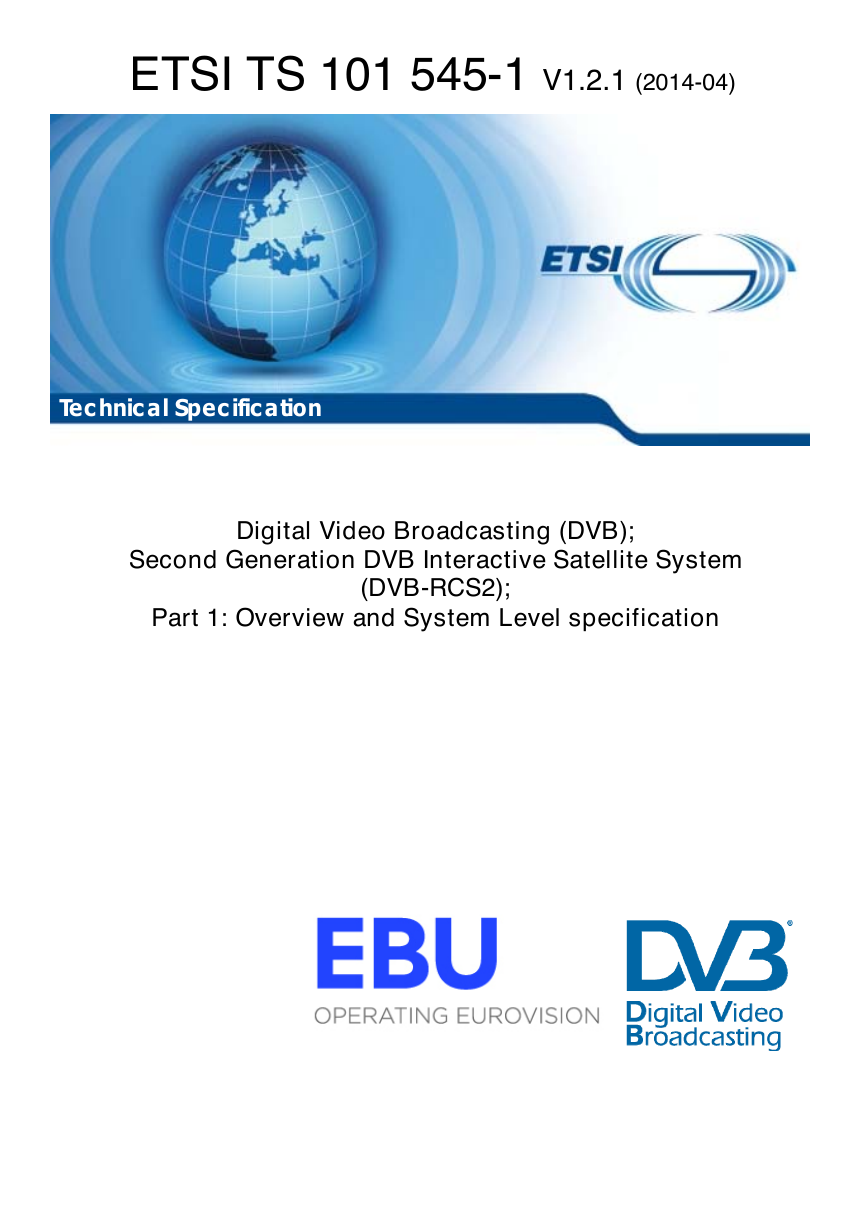
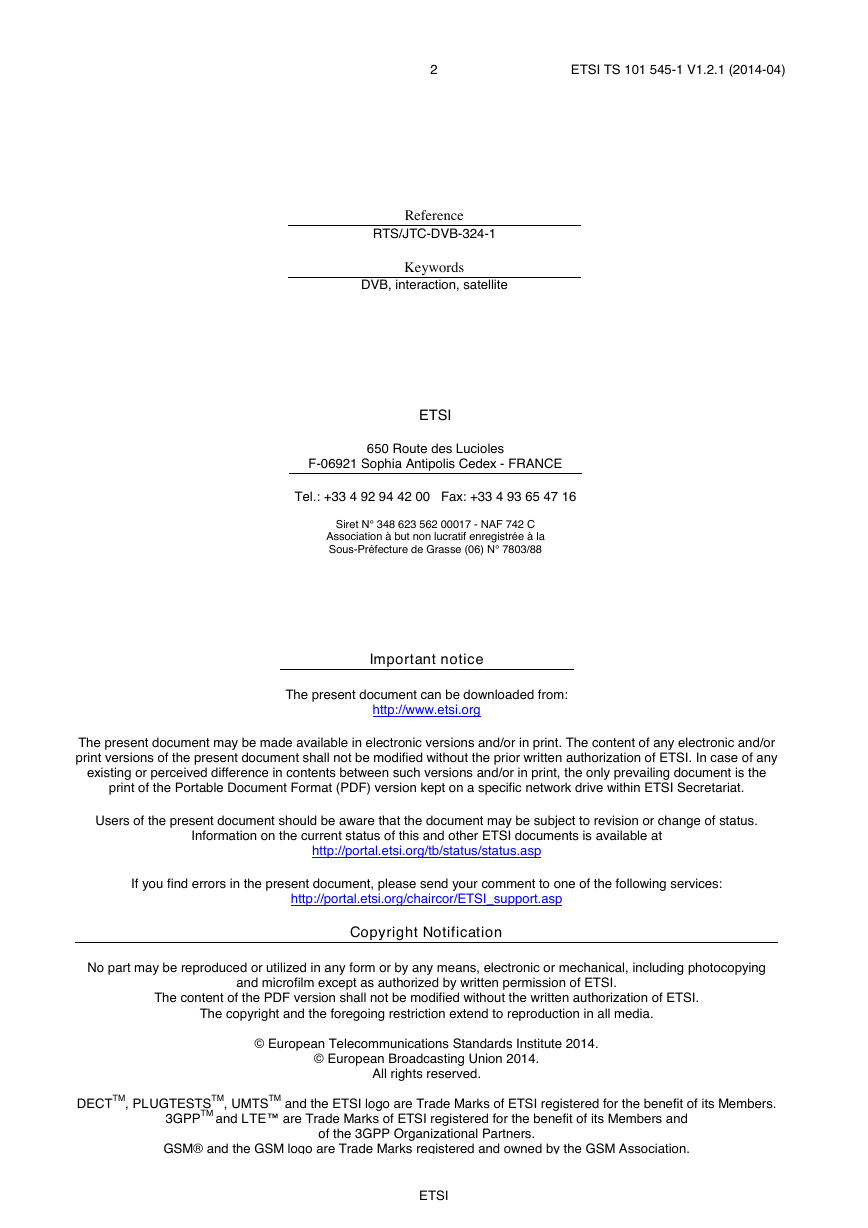
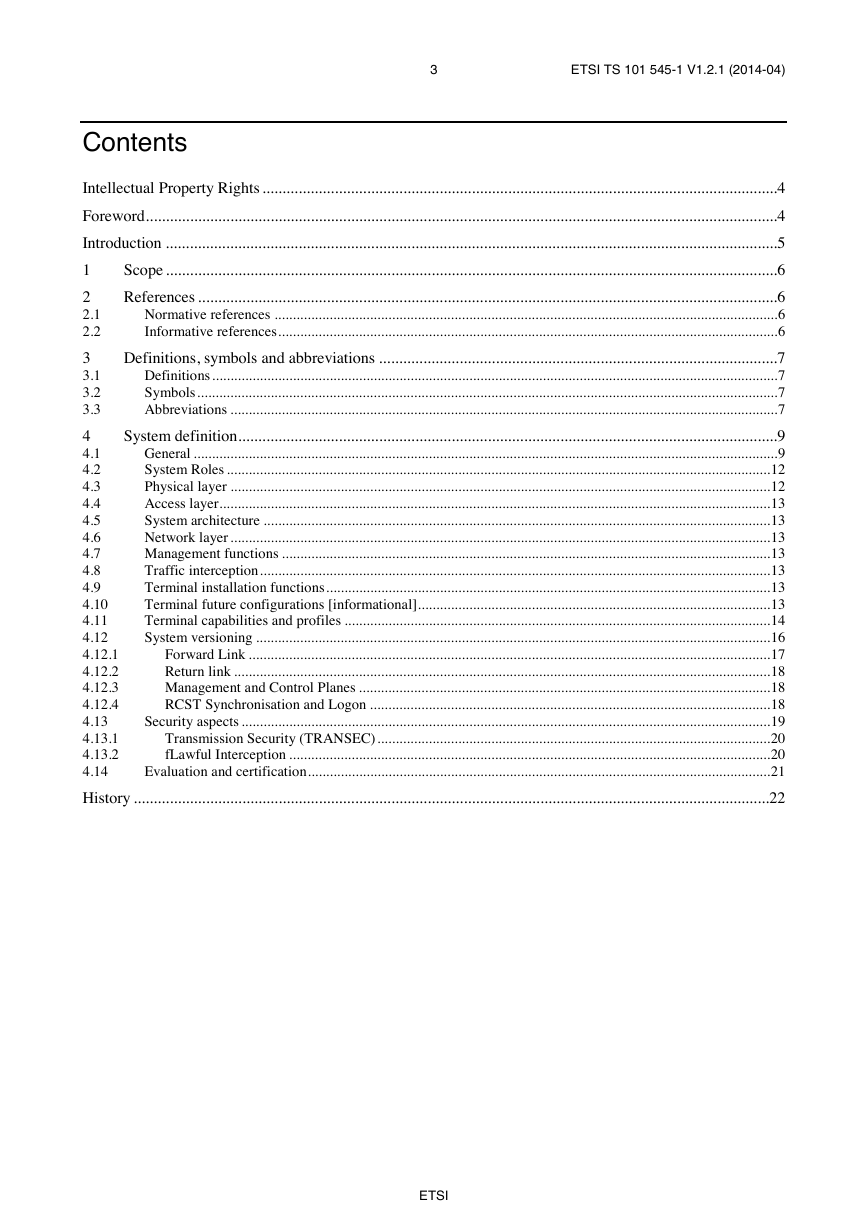

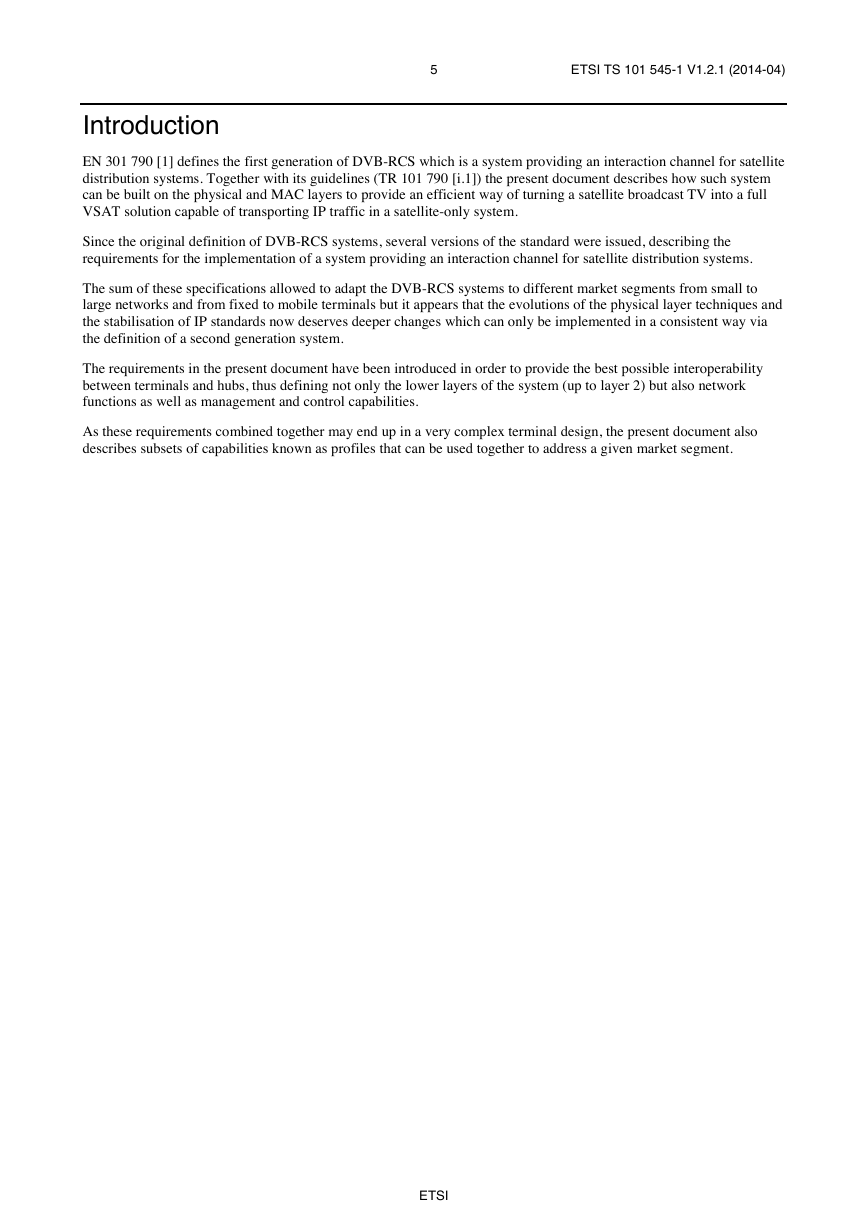
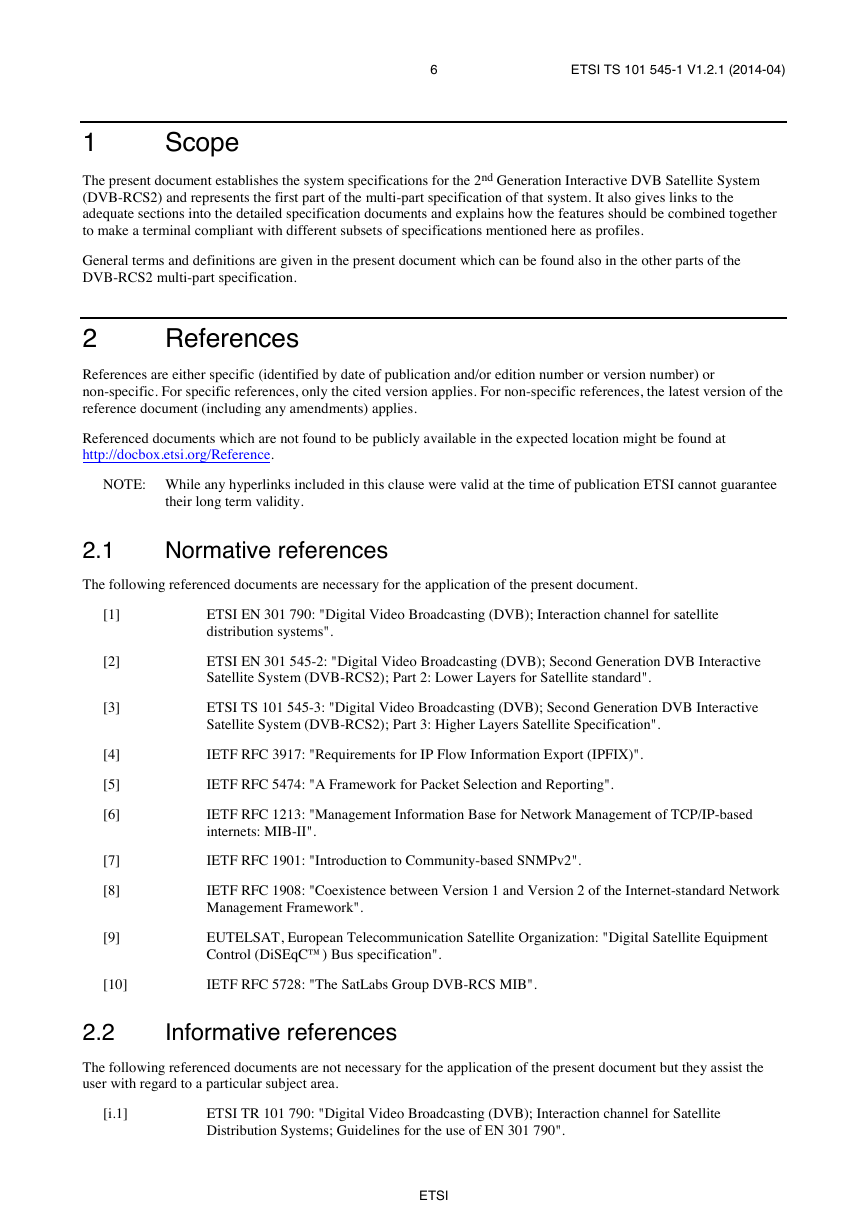
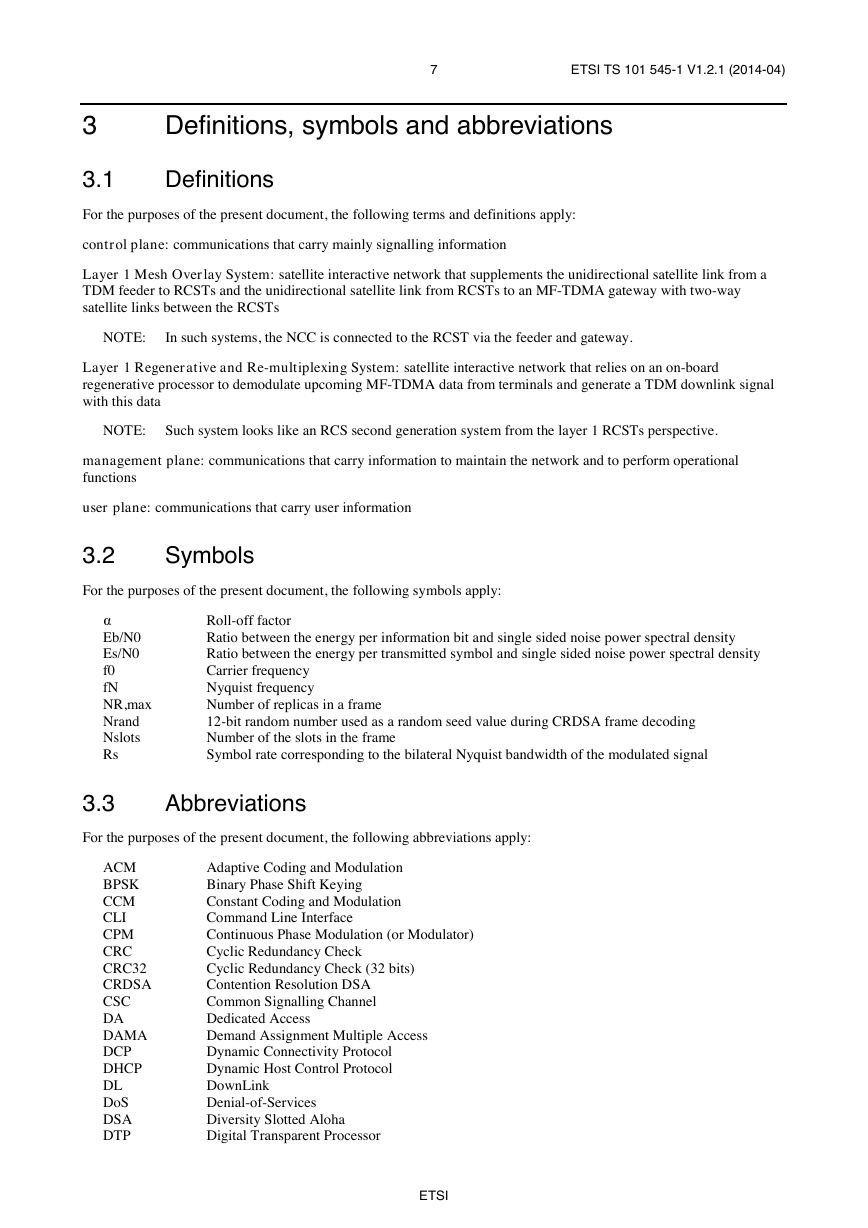
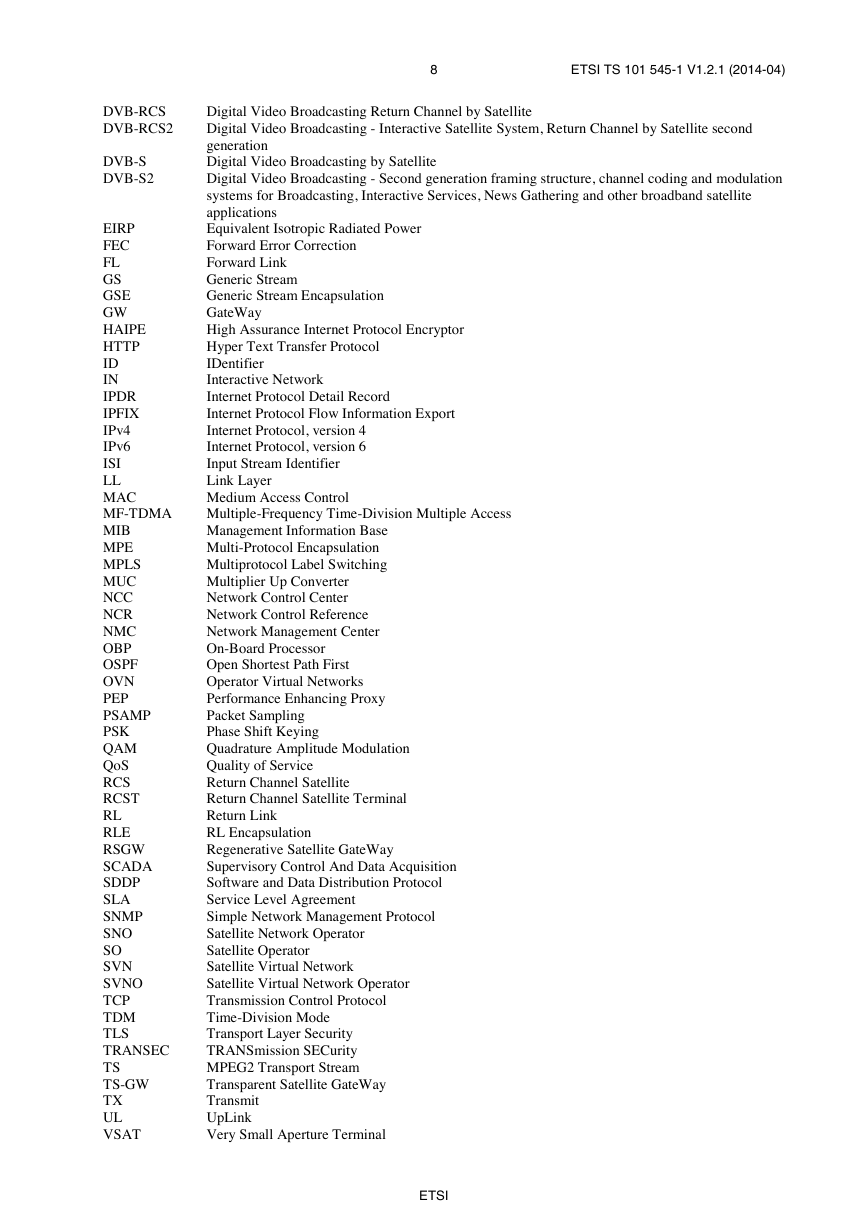








 2023年江西萍乡中考道德与法治真题及答案.doc
2023年江西萍乡中考道德与法治真题及答案.doc 2012年重庆南川中考生物真题及答案.doc
2012年重庆南川中考生物真题及答案.doc 2013年江西师范大学地理学综合及文艺理论基础考研真题.doc
2013年江西师范大学地理学综合及文艺理论基础考研真题.doc 2020年四川甘孜小升初语文真题及答案I卷.doc
2020年四川甘孜小升初语文真题及答案I卷.doc 2020年注册岩土工程师专业基础考试真题及答案.doc
2020年注册岩土工程师专业基础考试真题及答案.doc 2023-2024学年福建省厦门市九年级上学期数学月考试题及答案.doc
2023-2024学年福建省厦门市九年级上学期数学月考试题及答案.doc 2021-2022学年辽宁省沈阳市大东区九年级上学期语文期末试题及答案.doc
2021-2022学年辽宁省沈阳市大东区九年级上学期语文期末试题及答案.doc 2022-2023学年北京东城区初三第一学期物理期末试卷及答案.doc
2022-2023学年北京东城区初三第一学期物理期末试卷及答案.doc 2018上半年江西教师资格初中地理学科知识与教学能力真题及答案.doc
2018上半年江西教师资格初中地理学科知识与教学能力真题及答案.doc 2012年河北国家公务员申论考试真题及答案-省级.doc
2012年河北国家公务员申论考试真题及答案-省级.doc 2020-2021学年江苏省扬州市江都区邵樊片九年级上学期数学第一次质量检测试题及答案.doc
2020-2021学年江苏省扬州市江都区邵樊片九年级上学期数学第一次质量检测试题及答案.doc 2022下半年黑龙江教师资格证中学综合素质真题及答案.doc
2022下半年黑龙江教师资格证中学综合素质真题及答案.doc